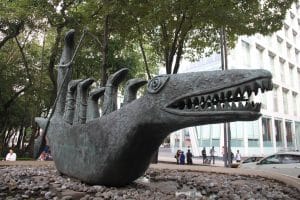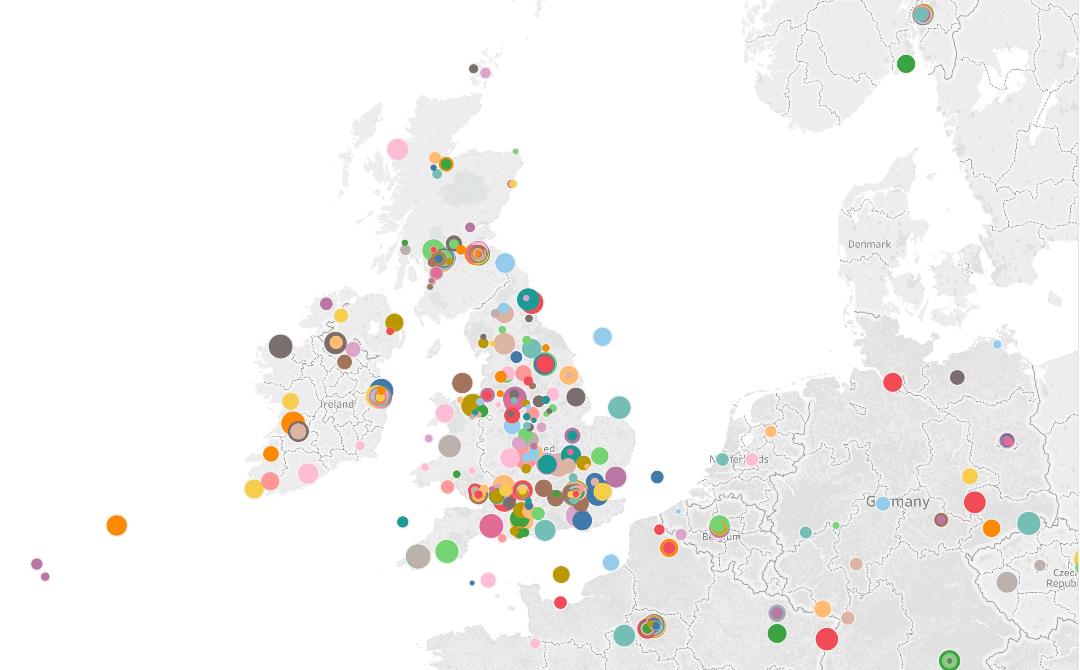 Founded in 1801, the Musée d'Arts de Nantes houses over 14,000 works spanning from the 13th century to contemporary art. Its collection includes pieces by Monet, Picasso, and Kandinsky. The museum underwent significant renovations, reopening in 2017 with expanded exhibition spaces. Nantes Métropole is now seeking contractors' proposals for the provision of Project Management for Exhibition Design and Build for an exhibition entitled "Surrealist Women: Artists and Connectors in the Surrealist Constellation" taking place from November 20, 2026 to April 5, 2027. The estimated contract value is €33,000.
Founded in 1801, the Musée d'Arts de Nantes houses over 14,000 works spanning from the 13th century to contemporary art. Its collection includes pieces by Monet, Picasso, and Kandinsky. The museum underwent significant renovations, reopening in 2017 with expanded exhibition spaces. Nantes Métropole is now seeking contractors' proposals for the provision of Project Management for Exhibition Design and Build for an exhibition entitled "Surrealist Women: Artists and Connectors in the Surrealist Constellation" taking place from November 20, 2026 to April 5, 2027. The estimated contract value is €33,000.
Musée d'Arts de Nantes: Project Management for Exhibition Design and Build of Surrealist Women Themed Exhibition
English language summary:
Project management services for the design and implementation of the scenography for the exhibition "Surrealist Women: Artists and Connectors in the Surrealist Constellation" (working title), scheduled from Friday, November 20, 2026, to Monday, April 5, 2027, at the Musée d’Arts de Nantes.
- Part 1: Being in the world: identity questioned Granting the expression of the unconscious a central role in the creative activity, surrealism is a search for the self. Often driven by their condition as women to question their place in the world, female artists have particularly taken up self-portraiture. The question of gender fluidity also marks their work. The figure of the androgyne, which runs through surrealism in general, finds a particular translation in their productions, questioning genders, their representations and their attributes. Finally, many female artists accord a singular importance to space as a metaphor for a state of mind (closed doors, references to the home, doubling of self and space in front of the mirror...).
- Part 2: A political view of the world Surrealism is a movement marked by its political commitments and its desire to revolutionize art and society. Although women are rarely present in the movement's political initiatives, the works of female artists reveal a keen attention to society. Most, as illustrated in Focus 1, have themselves confronted limiting social conventions. We thus observe a significant body of work questioning the place of women in society, expressing anxiety, irony or a desire for role reversal. Their works also demonstrate an intense concern for the way the world is going, marked in particular by the rise of authoritarianism and war, ranging from fear to resistance.
- Part 3: Perceiving and transforming the world: the laboratory of artistic alchemy Surrealism establishes an equivalence between reality and dreams, which are one, and offers their revelation (that of inner vision, of the unconscious buried beneath the superego, of that which escapes the control of reason...). Mysteries, the occult, but also alchemy, which allows the transmutation of bodies, are areas explored particularly in the works of women associated with surrealism. The theme of alchemical transformation becomes a metaphor for artistic creation and the quest for self. The search for correspondences to achieve harmony will open up the question of the diversity of artistic expressions: many of these women artists have indeed nurtured a multiple activity, visual and literary. Here, we will particularly emphasize writing, which will allow us to replace the importance of the text, the primary expression of surrealism. The disclosure of the mystery of the unconscious will also open up the automatic method, which allows the development of a surrealist abstraction.
- Part 4: Becoming One with the World The works of women artists associated with surrealism bear witness to a singular relationship with the female body. An object of desire for male artists (a theme that will not be explored further in the exhibition—it has already been the subject of numerous publications and exhibitions), it is the primary place of experience of the world for female artists. The works highlight a desire not to euphemize its material and psychological reality: suffering, illness, and the anxieties of motherhood run through the corpus. The body also asserts itself as a creative force (performances, fashion, etc.). Linking culture and nature, it also introduces hybridity. The creative possibilities opened up by the "chance encounter" of disjointed elements, in the tradition of Lautréamont, are notably translated into a fusion of the human, the animal, and the plant. Animals take on a symbolic dimension. The uninterrupted cycle of nature is linked to feminine creative capacities (in their physical reality and in art). Nature is also a metaphor: it offers the possibility of connecting individual interiority and the surrounding world, of projecting anxieties and life impulses onto it, of becoming one with the world. The journey will be punctuated by focuses. They will mix informative elements and iconography in compositions on the scale of a picture rail (wall paper type) and will address the following themes: "Being a woman and an artist: the itineraries of some personalities", "The "passeuses": they too made surrealism, on the margins of creation", "A constellation of artists: friendships, networks and collaborations", "To be surrealist or not?".
The exhibition may feature works by; Lola Alvarez Bravo, Marion Adnams, Eileen Agar, Jean Arp, Rachael Baes, Ruth Bernhard, Dorr Bothwell, Victor Brauner, Emmy Bridgwater, Claude Cahun, Leonora Carrington, Ithell Colquhoun, Salvador Dali, Maya Deren, Marcel Duchamp, Max Ernst, Leonor Fini, Alberto Giacometti, Jane Graverol, Frida Kahlo, Rita Kernn-Larsen, Jacqueline Lamba, Sheila Legge, Helen Lundeberg, Dora Maar, Maria Martins, Emila Medková, Lee Miller, Sonia Mossé, Meret Oppenheim, Mimi Parent, Valentine Penrose, Alice Rahon, Man Ray, Judit Reigl, Jeanne Reynal, Edith Rimmington, Rosa Rolanda, Kay Sage, Niki de Saint Phalle, Peggy Slinger, Stella Snead, Grete Stern, Eva Švankmajerová, Alina Szapocznikow, Dorothea Tanning, Elsa Thoresen, Bridget Tichenor, Toyen, Hélène Vanel, Remedios Varo, Paule Vézelay, Isabelle Waldberg, Unica Zürn. Sans oublier les écrits de Claude Cahun, Leonora Carrington, Ithell Colquhoun, Lise Deharme, Frida Kahlo, Joyce Mansour, Gail Pailthorpe, Valentine Penrose, Gisèle Prassinos, Kay Sage, Unica Zürn...
Original language summary:
Mission de maîtrise d’œuvre pour la conception et la réalisation de la scénographie de l’exposition « Femmes surréalistes : artistes et passeuses dans la constellation surréaliste » (titre provisoire), présentée du vendredi 20 novembre 2026 au lundi 5 avril 2027 au Musée d’arts de Nantes.
Structuration de l'exposition envisagée
- Partie 1 : Être au monde: l’identité questionnée Accordant à l'expression de l'inconscient une part centrale dans l'actif créatif, le surréalisme est une recherche sur soi. Souvent poussées par leur condition de femmes à s'interroger sur leur place dans le monde, les artistes femmes se sont particulièrement emparées de l'autoportrait. La question de la fluidité des genres marque également leur travail. La figure de l'androgyne, qui parcourt le surréalisme en règle générale, trouve dans leurs productions une traduction particulière, questionnant les genres, leurs représentations et leurs attributs. Enfin, de nombreuses artistes femmes accordent une importante singulière à l'espace comme métaphore d'un état d'esprit (portes fermées, références au foyer, dédoublement de soi et de l'espace face au miroir...).
- Partie 2 : Un regard politique porté sur le monde Le surréalisme est un mouvement marqué par ses engagements politiques et sa volonté de révolutionner l'art et la société. Si les femmes sont peu présentes dans les initiatives politiques du mouvement, les œuvres des artistes femmes révèlent une attention aiguë à la société. La plupart, comme l'illustre le focus 1, se sont elles-mêmes confrontées à des conventions sociales limitantes. On constate ainsi un corpus important d’œuvres interrogeant la place des femmes dans la société, traduisant angoisse, ironie ou volonté de renversement des rôles. Leurs œuvres prouvent également une préoccupation intense pour la marche du monde, marquée notamment par la montée des autoritarismes et la guerre, allant de l'effroi à la résistance.
- Partie 3 : Percevoir et transformer le monde : le laboratoire de l’alchimie artistique Le surréalisme établit une équivalence entre la réalité et le rêve, qui ne font qu'un, et en propose la révélation (celle de la vision intérieure, de l'inconscient enfoui sous le surmoi, de ce qui échappe au contrôle de la raison...). Les mystères, l'occulte, mais aussi l'alchimie, qui permet la transmutation des corps, sont des domaines explorés particulièrement dans les œuvres de femmes associées au surréalisme. Le thème de la transformation alchimique se fait métaphore de la création artistique et de la quête de soi. La recherche des correspondances pour atteindre l'harmonie ouvrira à la question de la diversité des expressions artistiques : nombre de ces artistes femmes ont en effet nourri une activité multiple, visuelle et littéraire. On insistera ici particulièrement sur l'écrit, qui permettra de replacer l'importance du texte, expression première du surréalisme. La divulgation du mystère de l'inconscient ouvrira également sur la méthode automatique, qui permet le développement d'une abstraction surréaliste.
- Partie 4 : Faire corps avec le monde Les œuvres des artistes femmes associées au surréalisme témoignent d'un rapport singulier au corps féminin. Objet de désir chez les artistes masculins (une thématique qui ne sera pas abordée plus avant dans l'exposition - elle a déjà fait l'objet de nombreuses publications et expositions), il est le lieu premier de l'expérience du monde pour les artistes femmes. Les œuvres mettent en évidence une volonté de ne pas euphémiser sa réalité matérielle et psychique: la souffrance, la maladie, les angoisses de la maternité traversent le corpus. Le corps s'affirme également comme un ressort créatif (performances, mode...). Faisant le lien entre culture et nature, il introduit également à l'hybridité. Les possibilités créatives ouvertes par la "rencontre fortuite" d'éléments disjoints, dans la lignée de Lautréamont, se traduisent notamment par une fusion de l'humain, de l'animal et du végétal. Les animaux prennent une dimension symbolique. Le cycle ininterrompu de la nature est mis en relation avec les capacités créatives féminines (dans leur réalité physique et dans l'art). La nature est également métaphore: elle offre la possibilité de mettre en lien l'intériorité individuelle et le monde environnant, d'y projeter angoisses et pulsions de vie, de faire corps avec le monde. Le parcours sera ponctué de focus. Ils mêleront éléments informatifs et iconographie dans des compositions à l'échelle d'une cimaise (type wall paper) et traiteront des thèmes suivants: "Être femme et artiste : itinéraires de quelques personnalités", "Les « passeuses » : elles aussi ont fait le surréalisme, en marge de la création", "Une constellation d’artistes : amitiés, réseaux et collaborations", "Être surréaliste ou pas?".
The exhibition may feature works by; Lola Alvarez Bravo, Marion Adnams, Eileen Agar, Jean Arp, Rachael Baes, Ruth Bernhard, Dorr Bothwell, Victor Brauner, Emmy Bridgwater, Claude Cahun, Leonora Carrington, Ithell Colquhoun, Salvador Dali, Maya Deren, Marcel Duchamp, Max Ernst, Leonor Fini, Alberto Giacometti, Jane Graverol, Frida Kahlo, Rita Kernn-Larsen, Jacqueline Lamba, Sheila Legge, Helen Lundeberg, Dora Maar, Maria Martins, Emila Medková, Lee Miller, Sonia Mossé, Meret Oppenheim, Mimi Parent, Valentine Penrose, Alice Rahon, Man Ray, Judit Reigl, Jeanne Reynal, Edith Rimmington, Rosa Rolanda, Kay Sage, Niki de Saint Phalle, Peggy Slinger, Stella Snead, Grete Stern, Eva Švankmajerová, Alina Szapocznikow, Dorothea Tanning, Elsa Thoresen, Bridget Tichenor, Toyen, Hélène Vanel, Remedios Varo, Paule Vézelay, Isabelle Waldberg, Unica Zürn. Sans oublier les écrits de Claude Cahun, Leonora Carrington, Ithell Colquhoun, Lise Deharme, Frida Kahlo, Joyce Mansour, Gail Pailthorpe, Valentine Penrose, Gisèle Prassinos, Kay Sage, Unica Zürn...
For further information, interested contractors should go to this link.
The deadline for submission of proposals is 12 June 2025 by 12 pm.
Contact:
Nantes Métropole
2 cours du Champ de Mars
44923, Nantes
France
Contact point: MME Léa PIERRE
Tel: +33 240419000
Contact.marches@nantesmetropole.fr
Image: Sculpture of Crocodile by Leonora Carrington Gary Todd from Xinzheng, China, CC0, via Wikimedia Commons






